Are you a believer in making each cast count? Then you will love the T-Wing System. Here's a breakdown of what makes Daiwa's TWS so great.
More...
Henry Ford is quoted as having said something that, when you think about it, strikes home.

While he didn't invent the automobile, he did help millions of Americans get into one at an affordable price, in a world where transportation needs were dominated by horses and autos were only for the wealthy.
Daiwa has taken a similar approach to casting reels, improving a rather ordinary feature to offer an advantage no one knew to ask for.
One of those innovations is Daiwa's TWS, or T-Wing System.
What is the T-Wing System?
The T-wing System is a special level wind offering maximum performance on the retrieve and, most importantly, the cast.
How does it increase performance?
To really explain this we must first understand the dilemma manufacturers face when designing a good casting reel.
The Problem with Levelwinds
There's a balance reel manufacturer's must strike with a levelwind's aperture, somewhere between too big and too small.
See, a small aperture packs line tighter and more evenly than a large one.
This sets up the next cast for success, because an evenly packed, tight spool casts better than a loose and uneven one.
Problem is, line doesn't pass through a tiny aperture that well, especially considering that the aperture is never in the same place for each cast; it can be anywhere along the worm gear.
Instead, line passes through a larger aperture more easily, at the expense of an unevenly packed spool once the retrieve is complete.
- smaller aperture = better for the retrieve
- larger aperture = better for the cast
Most reel companies do their best to strike a balance with an aperture that's not too small and not too big, but Daiwa goes all the way with a level wind that provides both.
This is possible because the T-Wing System changes its orientation between casts to create a different sized aperture:
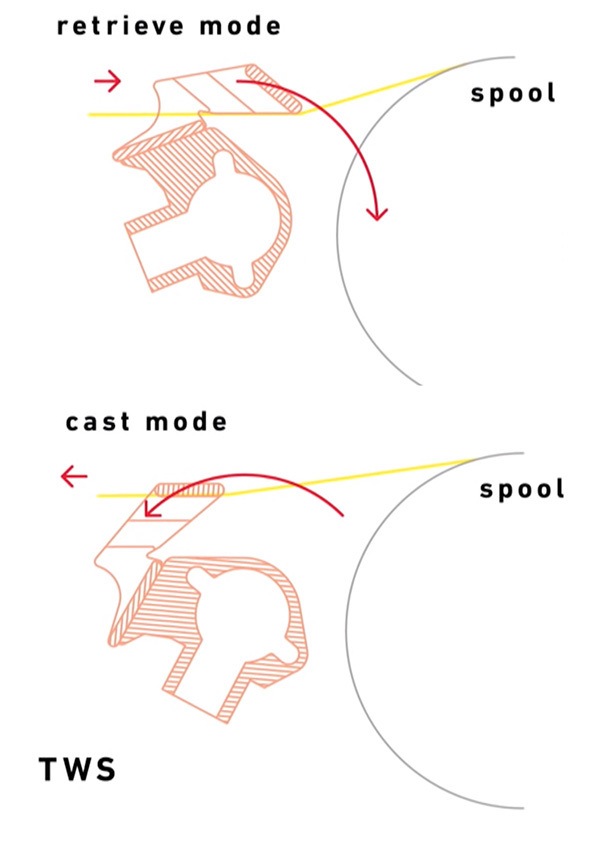
Other level winds are not as advanced because all other level winds are just a hole line passes through.
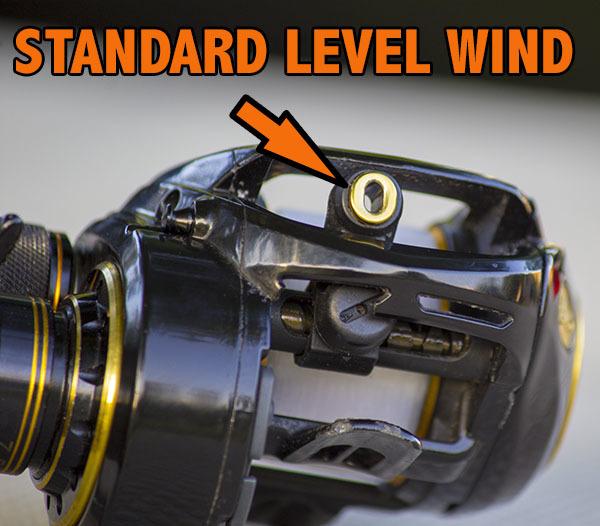
This is a standard level wind found on non-Daiwa reels.
The Best Aperture For Retrieving
During the retrieve Daiwa's T-wing sits upright, evenly packing line for the next cast with a small aperture.
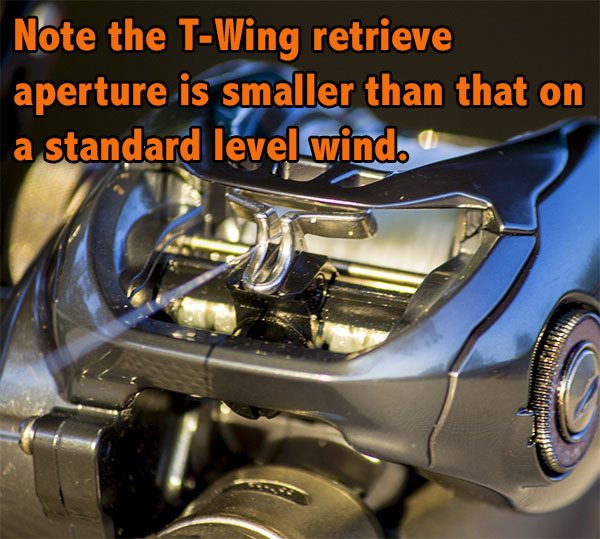
A Special Aperture For Casting
The T-wing switches from a small to wide aperture when you click down on the clutch control.
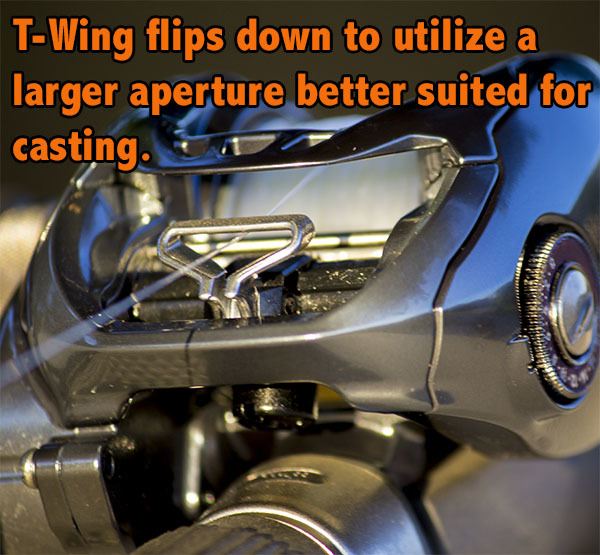
This allows for line to come off the spool at a shallower angle than what conventional level winds are capable of, reducing friction and the odds of line "digging in" on itself, especially with braid.
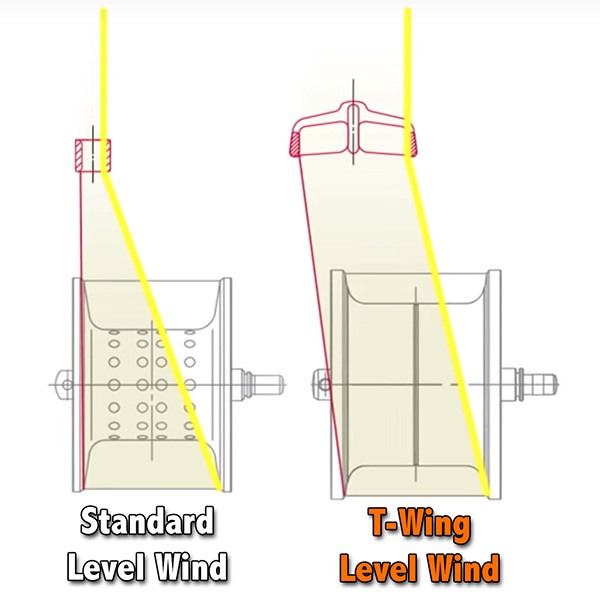
The T-Wing System guides line off the center line of the spool, regardless of its position.
The Major Benefit You Get From T-Wing Performance
Daiwa's TWS enables you to make more casts that go farther, giving you the option to cover more water and get more presentations on fish, especially with braid.
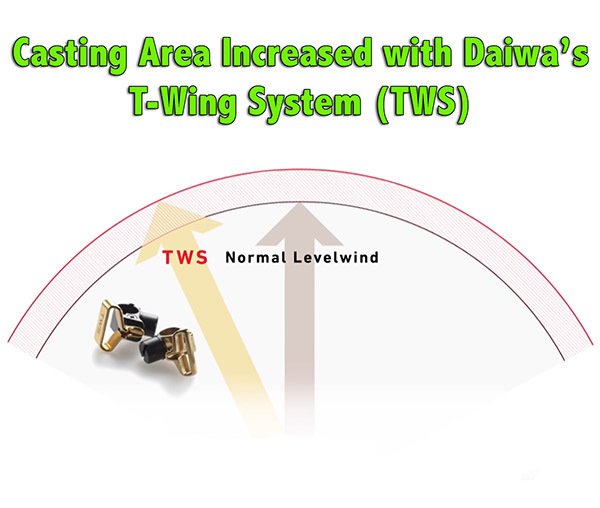
It's simple math: longer casts happening more often = better odds of getting bit.
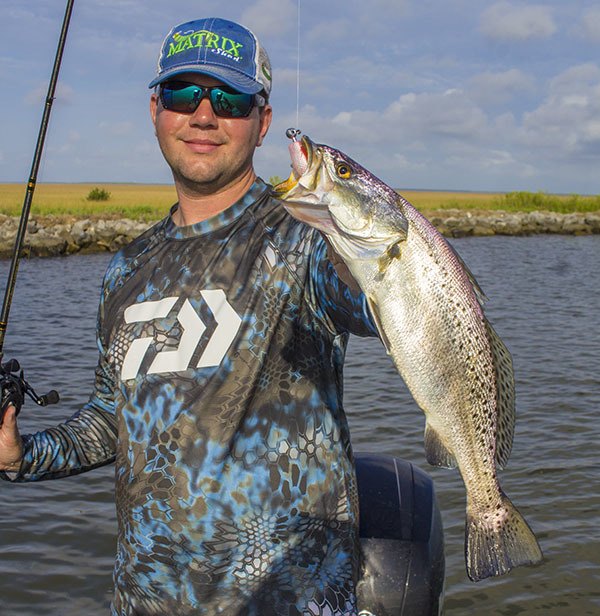
It's knowing where to find biting fish that ultimately puts them in the boat, but Daiwa's T-Wing System does offer an advantage to anglers looking to gain an edge.
Conclusion
There's a lot of gimmicks and slimy marketing out there, but Daiwa's T-Wing System isn't one.
No, the TWS is intelligent innovation from an established company that's been in the game for over 60 years.
Don't get me wrong!
This doesn't mean all reels with conventional level winds are outdated and not worth your dollar, but if you're a strong believer in 3% Theory and want an edge, then Daiwa's TWS is something to consider.
Have a question or something to add? Then please comment below!
Looking for opinions from other anglers? Just ask inside LAFB Elite's Community.

Rodney, almost all Daiwa reels currently offered have the T-Wing system on them.
My Dad still has a couple of those. I’m not sure why they don’t use that design again on a modern real. It didn’t really catch on back then, but every time I look at those my Dad has, I wish I could get a new reel with that spool guide design.
Thank you, Mark!
great explanation. your stuff is getting better and better Devin.
Amen to that.
The T-Wing is awesome.
Wow, that’s awesome.
I’ve got an older Daiwa around here somewhere, from the 90s, but not as old as yours.
Thanks for commenting, John.
My first bait-caster reel was a Daiwa “Magforce” PMA33SL (I think 7.2:1 ratio). When the thumb bar was depressed…The line “guide” would totally separate from whatever previous-position, divide/slide in half to the farthest ends of the guide-bar. Thus, allowing NO FRICTION on the line while being dispensed/cast out. Then on the initial turn of the handle, the separated guide would come together within a 1/16″ and evenly layer the retrieved line onto the spool. Still have that 40+ yoa reel, 6 years ago, Professional Sport Shop after last cleaning/maintenance advised that the parts are no longer available. Still operating and functioning like the Energerize Rabbit…
Nice, will keep an eye on this for my next reel
100% agree on the “it’s one more thing to fail” perspective.
I like simple stuff, but in recent years have been giving the “fancier” stuff a fair chance.
Some things have proven to be garbage, others have been great.
One Tatula I have featuring the T-Wing has been to Central Rig, Long Rocks, a lot of places and still performs great.
Actually, it free spins longer than a Core 100Mg I have, so that was interesting.
I’ve posted videos of that on social media, but will be sure to include them here.
Interesting. I will be keeping and eye on these. It seems like another moving part to fail, but I can see how it would make a substantial difference. Please keep us updated with any issues or pleasant surprises.
Not at all.
It’s just as smooth, if not smoother, than other reels I’ve owned.
You’d go to think so, but if you go look at the MSRP of TWS-equipped reels you’ll see they’re priced the same as their non-Daiwa counterparts.
I think the reason why is that Daiwa invests in innovation rather than promoting.
Hey Steve, thanks for commenting!
I run several Daiwa Tatula’s equipped with the TWS and so far, so good.
No issues at all.
No dry grease, no corrosion, no rusting, nothing.
how does it hold up in the salt
thank u
– Steve
You make a lot of good points, but wouldn’t this make T-Wing equipped reels pricier?
Not sure I want to dish out any extra dough for a reel that gives only a slight advantage.
Does it make pushing the button down harder?